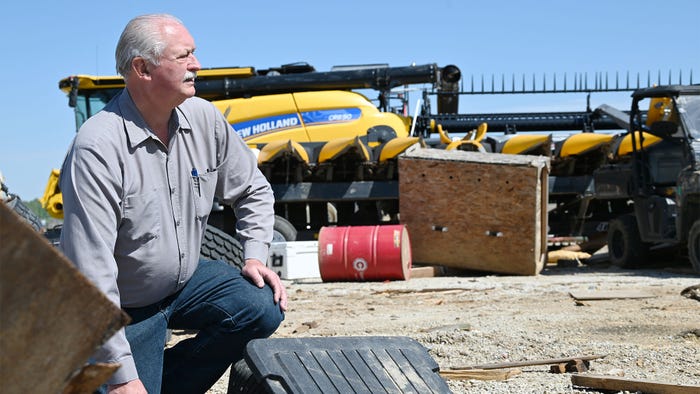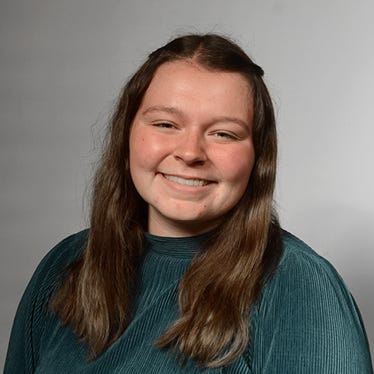May 6, 2024

April 2, 2024, will forever be the day the Krons’ world turned upside down.
“It just felt like something hit the house,” says Joyce Kron. “Real quick, you run into the basement.”
That day, a tornado tore through the Kron farm in Evansville, Ind., leaving Randy Kron, Indiana Farm Bureau president; his wife, Joyce; and the rest of their family to pick up the pieces.
“You see things on the news when this happens other places,” Joyce says. “When you live it, it’s so much different than when you see the pictures. You see pictures on the news of two-by-fours jammed in the ground. We had that.”
In its wake, the tornado left a demolished grain storage setup, a toppled barn, a roofless shop that was doomed to cave in, and a severely damaged house where Randy and Joyce’s son, Ben, lives. Joyce recalls not knowing where to even start.
“You have all this happen, and it takes a minute for you to wonder, what in the world do you even do?” she adds.
Help arrives
The Krons didn’t have to ponder that question of where to start for too long. As quickly as the tornado had ripped through, neighbors began flocking to the farm. They asked how they could help and what they could give, or offered positive thoughts and prayers in that period of the unknown. Insurance was an important next step.
“I’m so grateful that I had the help and support of Indiana Farm Bureau Insurance,” Randy says. “This type of situation is exactly why the insurance company was created — to help our members when they need it the most.”
Almost immediately, Randy and Joyce’s son-in-law, Daniel Langton, brought over equipment from his family’s business, Russell’s Excavating. He started clearing a path so they could get into the driveway. Over the next few days, the excavating equipment continued to help make the mess from the tornado more manageable.
Beyond that, Joyce says they worked their way through a constantly changing to-do list that was determined by the severity of different issues around the farm.
“You try to assess what’s the most pressing need at the moment,” Joyce explains. For them, this was clearing out their grain bins full of soybeans before more rain came in the next few days.
This dilemma was solved quickly. A handful of neighbors appeared with semitrucks and trailers, while another brought his grain vac. In a couple of days, all the grain had been removed and hauled to local elevators.
Moving other objects under roof posed a problem because all the roofs at the farm had been ripped off by the tornado. No barn or shop on-site was usable. Randy got ahold of some sea shipping containers to house tools, electrical components and other supplies while they waited for a new roof on their shop. Community members extended their help to this venture, carrying objects from the shop and barn into those shipping containers.
It takes a village
That help from community members was sparked by Joyce’s Facebook post. She simply stated that they would be cleaning some of the mess on the Saturday following the tornado, and anyone was welcome to join. Over 20 people showed up.
By Friday, Randy and Joyce were both exhausted. But that Saturday, they were amazed by the number of people who showed up and asked how they could help. Joyce even had a friend she hadn’t seen in about 30 years come out to the farm, eager to help.
The volunteers walked farm fields, moved items under roof and raked the yard to get the debris under control. Many more volunteers brought food or reached out to see if there was anything else they could do.
“I don’t know how many texts I got,” Randy adds. “There were a few days where you couldn’t even keep up with responding to them. That just tells you the support you have.”
The Krons’ minister and church family showed up to help, plus local farm businesses. Folks from Superior Ag headed to the farm to assist in recovery efforts. Farm Credit dropped off food. Randy and Joyce were quickly humbled by the hundreds of people who supported them in the aftermath of the storm.
“The farm community is pretty good in tough times at pulling together,” Randy says.
Shifting focus back to farming
That farm community also recognized the need for Randy to have everything ready for planting season. One of the most pressing issues was having a roof on their shop. Their builder, Phil Wittmer, squeezed them in between other projects, recognizing the importance of having that building for planting season.
Wittmer and his team had erected the four walls and roof of the shop in just days. While they have a space now, Randy is confident that neighbors would have fixed that problem too.
“I’m sure if we asked a neighbor, they’d let us do whatever,” he says. Joyce adds that their neighbors’ generosity extended to equipment, as several offered the Krons use of any machinery that they’d need to get through planting season.
Fortunately, Randy’s machinery suffered minor damage that will not set him back. He adds that their equipment dealer, Blesch Brothers Equipment, said they would do whatever it takes to ensure the Krons have what they need.
Randy and Joyce say they’ve been overwhelmed by the support, and they cannot even begin to express their gratitude. Without their farm community, they would not be back on their feet.
“Thank you doesn’t seem like enough because it means a lot,” Randy says. “I don’t know what else to say but ‘thank you.’”
Read more about:
DisasterAbout the Author(s)
You May Also Like






